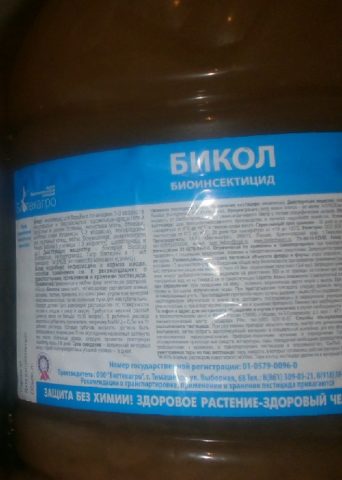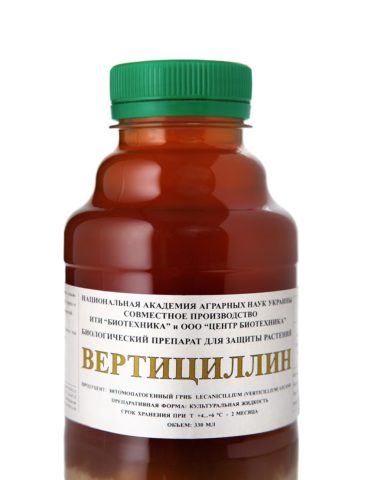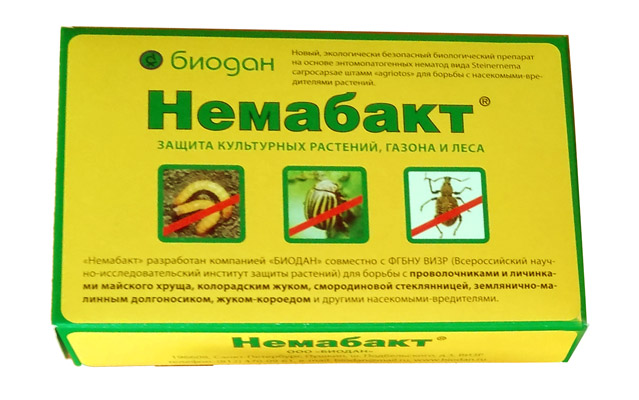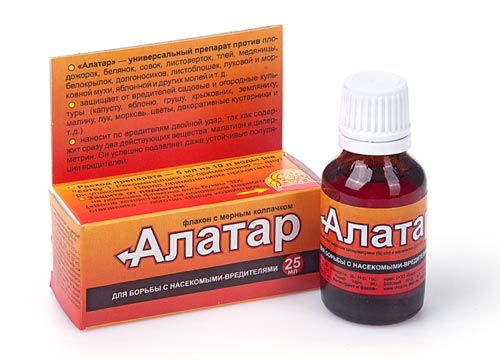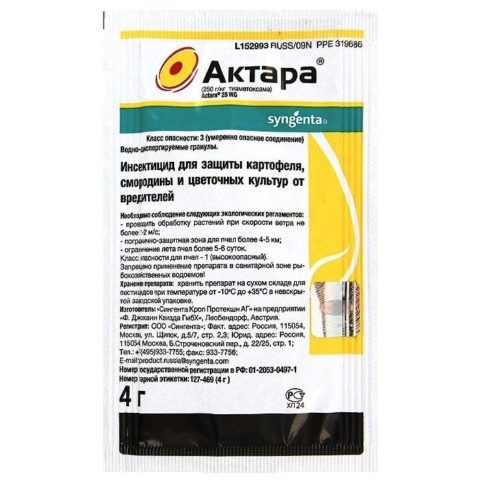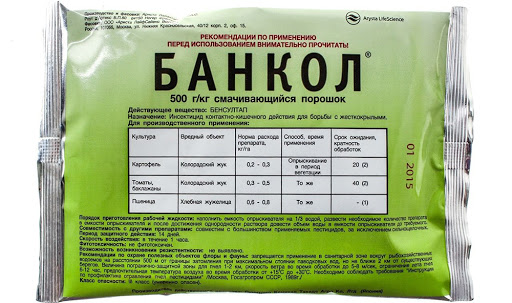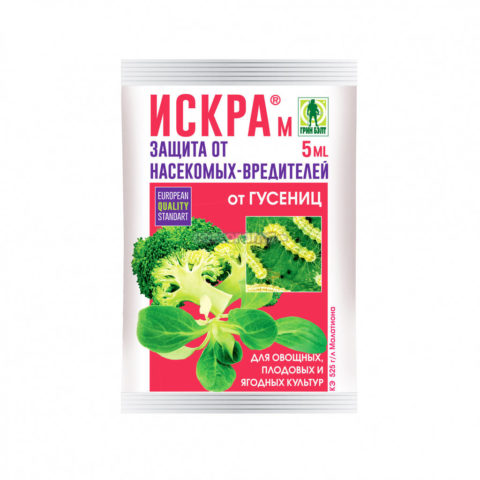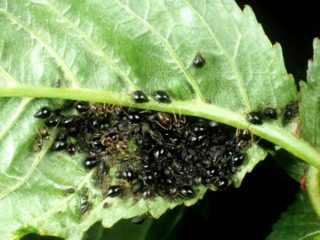Content
Cabbage pests do not provide an opportunity to grow a high-quality crop. Before taking measures to protect against insects, it is important to know how the drugs affect the human body.
Features of cabbage insect pests
Pests of white cabbage attack the plant during the entire growing season. Damage in the first weeks after planting, when the bush has not yet matured, is a great danger. If the defeat is massive, then the head of cabbage will not be able to start.
During the entire summer season, it is necessary to carry out measures for protection. It's worth starting with the safest methods. If they do not bring the desired result, then you will have to use biological or chemical drugs.
Description of cabbage pests
A common cause of drying and death of cabbage is pest damage. They attack at different periods of plant development. Insects reproduce not only on the trunk, leaves, but also in the root system.
Cruciferous flea
Cabbage pests in greenhouses and in the open field appear at different periods. The cruciferous flea begins to harm at the time of seedling germination. Small beetles hibernate in the ground in plant debris. As soon as it gets warm, they crawl out of the hiding place and begin to eat all crucifers that they meet on their way. At first, they feed on weeds, and then move to fresh cabbage seedlings, only planted in the ground.
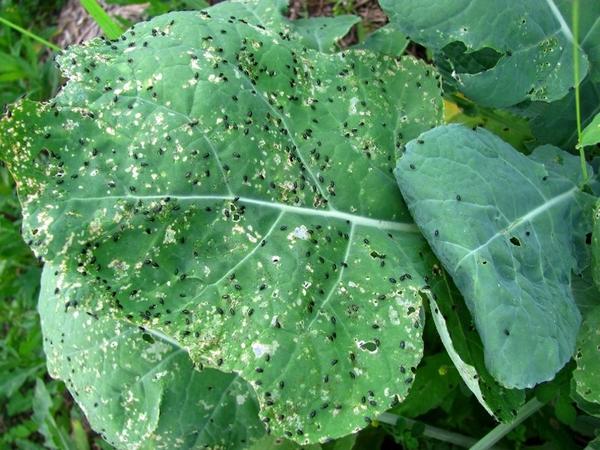
The cruciferous flea feeds on the top layer of leaf tissue
Cabbage fly
The cabbage fly is a gnawing pest. Lays eggs near the plant in late May. After a week, the larvae appear. Their life cycle takes place at the bottom of the stem and root system. Damaged plants begin to rot. There is a noticeable wilting of the head of cabbage, and the lower leaves acquire a lead tint.
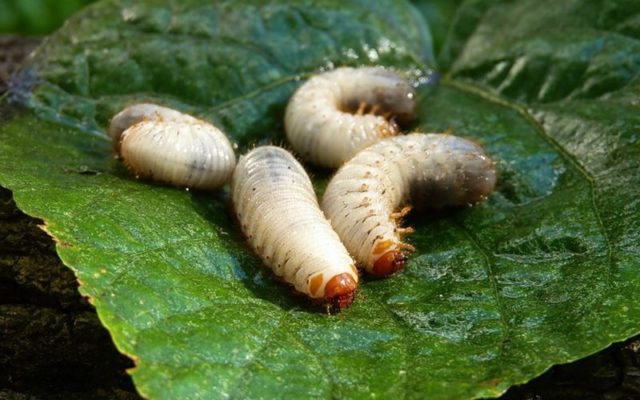
Cabbage fly larvae are invisible to the eye, so the problem is often discovered after the death of the plant.
Cabbage white
The cabbage whitewash is a moth. There are black spots on its white wings. She lays about 100 eggs at a time. Caterpillars appear in a week and a half. They are very voracious and eat cabbage whole in a short time. Only streaks are left. At the moment of moving through the leaves, the pest leaves a smelly, green trail. Therefore, the affected head of cabbage can be felt from afar by the unpleasant smell.
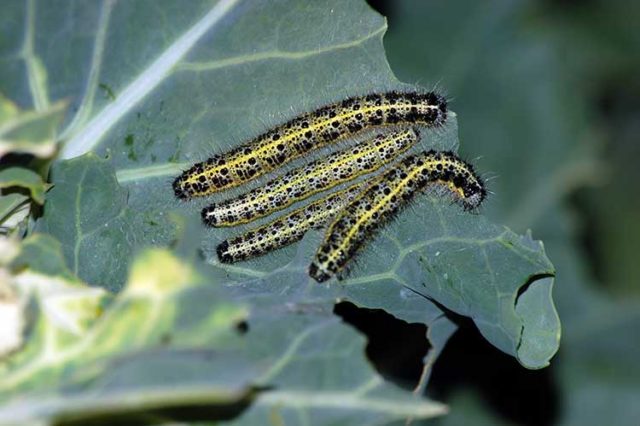
After watering, the tracks left by caterpillars give off a particularly strong, unpleasant odor.
Aphid
Aphids are the main sucking pest of kaputa. Prefers to dwell on the lower part of a young leaf. In spring, the pest settles on weeds, and then flies to young seedlings. Numerous attacks on cabbage occur in June and then in August. At this time, it is imperative to carry out preventive treatment.
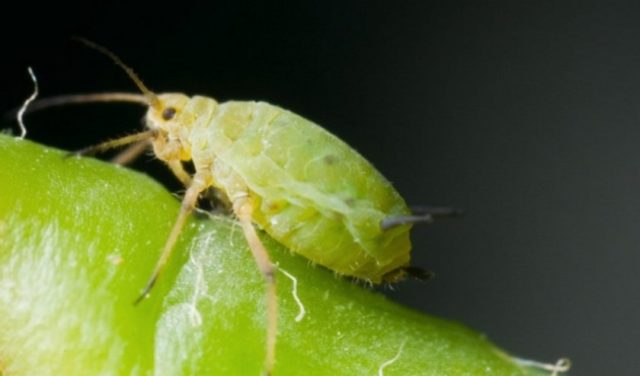
Aphids prefer young cabbage leaves
Thrips
Thrips suck out juices and leave a large amount of excrement on the leaf, which looks like black dots. The first manifestation is the whitening of the sheet plate. In the advanced stage, the leaves become more brown, then dry up and fall off. They are afraid of constantly wetted areas. Therefore, pests are most active in dry times.

To prevent thrips from spreading, the soil is treated regularly throughout the summer season.
Cruciferous bug
The cruciferous bug is a brightly colored insect. Yellow, white, red stripes stand out on a black background. Damages cabbage foliage. The pest sucks out plant juices. The leaves begin to change their natural color to yellow. Marble spots form on the surface. Head of cabbage stops forming. Its texture becomes soft and ugly. The young plant dies quickly.
The biggest harm to cabbage is caused by the larva that emerges from the eggs. She has no wings, so she is completely attached to the head of cabbage, feeds on it, quickly destroying the entire plant.
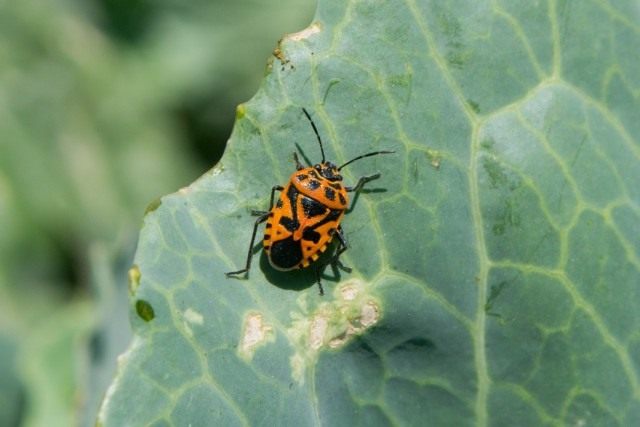
Cruciferous bugs can be harvested by hand, greatly reducing their numbers
Cabbage moth
The cabbage moth flies from one plant to another and lays several hundred eggs. Over the summer, 6 generations of pests develop. Each individual grows quickly and devours cabbage leaves around the clock. Small green caterpillars cause harm to the plant.
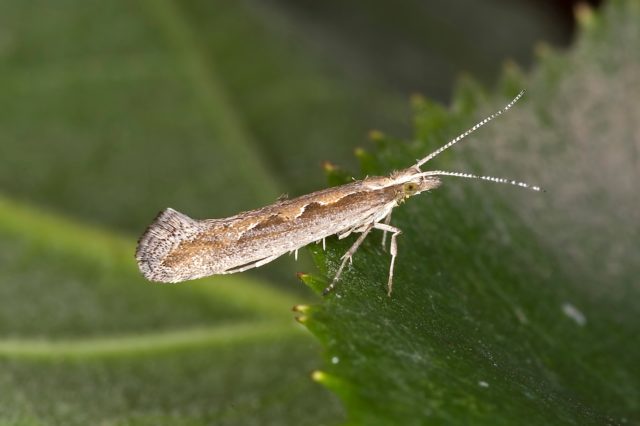
If you do not fight the cabbage moth, then every month the number of individuals will increase.
Slugs
Slugs eat the pulp of the leaves at night. During the day they sleep in the shade of cabbage. If you can see eaten edges on the head of cabbage, then you need to look for a pest nearby.
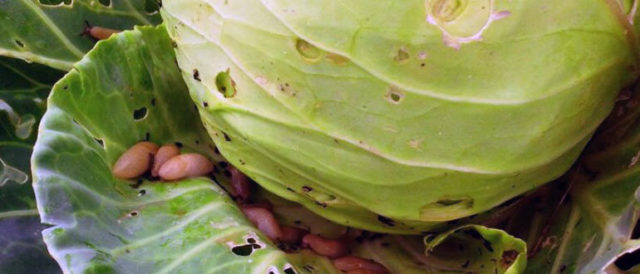
Slugs can hide in the most secret places of the head of cabbage
Medvedka
Medvedka is a pest of the root of cucumbers and cabbage. Leads a nocturnal lifestyle. Begins to gnaw the root system, while affecting the root zone of the stem.
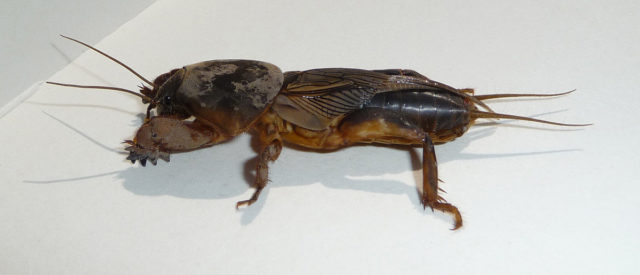
Medvedka lives underground and occasionally crawls to the surface at night.
Scoop butterfly
The scoop butterfly is a nocturnal pest. It lives in warm regions. She lays about 2700 eggs on the underside of cabbage leaves. After about 6-8 days, colored caterpillars appear. For wintering, they are buried in the ground to a depth of 10 cm. In warm climates, the pest forms 3 generations per season, in cold climates - one.
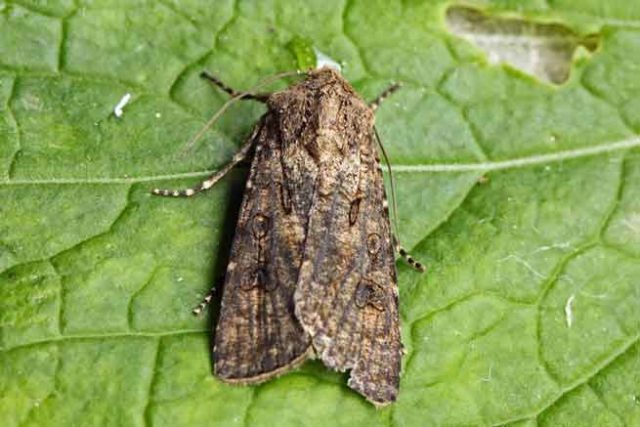
The scoop has a beige-brownish color of the wings
Wireworm
The wireworm is a small beetle. He makes holes in the underground part of the cabbage plant. As a result, the stem and root begin to rot.
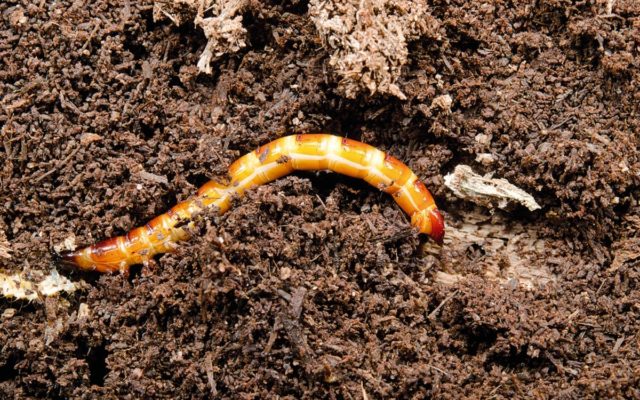
The wireworm larva looks like a piece of copper wire
Stem Lurker
The larvae of the stem lurking proboscis live in the stems of the seedlings. They eat out passages in them that harm the cabbage. Seedlings begin to lag behind in growth. After they are transplanted to the garden bed, they begin to wither and dry out completely.
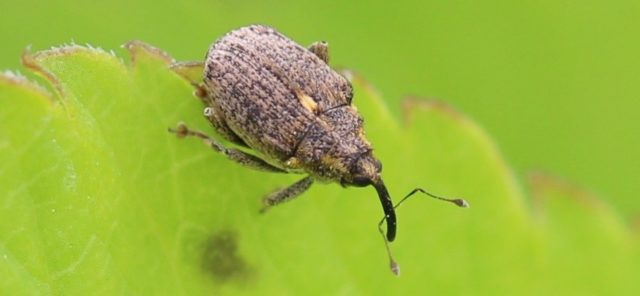
Stem lurker gnaws holes in the leaf blade
How to deal with cabbage pests
Pest control of cabbage in the open field is divided into 3 methods:
- Chemical. This is a quick but not safe method for human and animal health.
- People's. Doesn't always bring the desired result. Promises to destroy pests with herbal decoctions. Not all recipes are safe for your health.
- Biological. It takes a lot of time and system processing. Completely safe for the body.
Biological products are allowed to be combined when preparing mixtures against cabbage pests. The funds have a systemic and contact effect on the insect's nervous system. Gnawing pests stop feeding after 6 hours, and the death of suckers occurs after about 10 hours.
Most often, gardeners use:
- Aktofit. It helps to destroy aphids, cabbage whites and moths, scoop. Also eliminates gnawing and sucking pests.
1 treatment is enough, after 12 hours the problem will be resolved
- Bicol. It fights against aphids, bedbugs and other suckers.
Bicol is completely safe for humans
- Verticillin. Eliminates whiteflies and aphids.
The tool will help get rid of pests at any stage of crop development
- Nemabakt. Used against wireworm, cabbage fly, thrips, locusts, bear.
The drug can be used on any planting areas
- Pecilomycin. Fights nematodes.
Effective against root-eating pests
How to save cabbage from pests with folk remedies
Infusion will help from aphids. To prepare it you will need:
- onion peel - 500 g;
- water - 12 liters;
- liquid soap;
- tops - 2 kg.
Step by step process:
- Boil 5 liters of water.
- Pour boiling water over the tops. Cover with a lid.
- Leave on for 4 hours. Put on minimum heat. Cook for 3 hours.
- Strain. Measure the volume, add 2 times more liquid.
- Boil 2 liters of water. Pour in the husk. Insist 2 days.
- Add another 2 liters of water. Pour in some liquid soap.
- Combine infusions.
Spray the heads of cabbage with the resulting mixture.
You can get rid of caterpillars in simple, safe ways:
- Combine 200 g of ash with 10 ml of shampoo and 5 liters of water. Stir and leave for 1 day. Strain and spray with a spray bottle.
- Sprinkle with baking soda regularly.
- If there is not enough cabbage, then manual picking is effective.
Garlic broth is used as a universal remedy for almost all cabbage pests.
Another trick is the eggshell, which looks like the wings of a white butterfly. The pest, seeing the shells, takes them for competitors and flies away to another place.
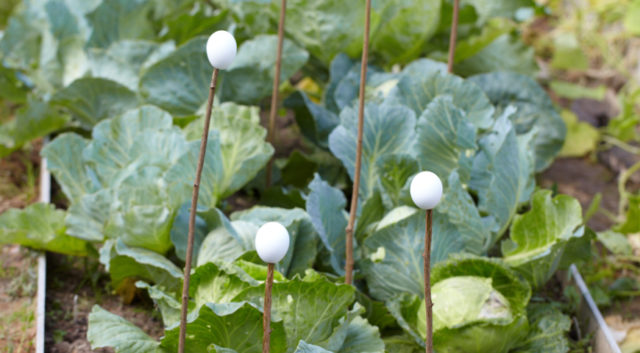
Eggshells can be worn on tall sticks to scare away butterflies
A decoction of tobacco helps against aphids. You will need:
- water;
- tobacco leaves - 450 g;
- soap - 50 g.
Step by step process:
- Pour 2 liters of water over the leaves. Boil for 2 hours.
- Strain. If the soap is lumpy, then you can first grate it. If it is liquid, immediately add to the broth.
- Connect with a bucket of water.
Fighting cabbage pests with vinegar is an effective folk way. It especially helps against fleas and whites. You will need:
- vinegar 70% - 10 ml;
- water - 5 l.
Step by step process:
- Combine water with vinegar.
- Spray the plant abundantly on all sides. The procedure can be repeated weekly.

The net will help protect the heads of cabbage from insects
How to save cabbage from pests with chemicals
This method is highly undesirable, as the cabbage forms a head of cabbage, which prevents the remaining preparation from being washed into the ground. As a result, the chemical will end up on the table with the crop.
If the situation is catastrophic, then the method is applied until the head of cabbage begins to form. This period lasts for the first few weeks after the cabbage seedlings are planted. After that, preference should be given to the folk or biological method.
In spring, seedlings can be sprayed with the following compounds:
- Alatar;
The tool destroys up to 28 types of pests
- Aktara;
The drug can also be used for indoor plants.
- Decis.
Decis is bred strictly according to the instructions in the instructions.
There are also adapted tools. This means that they are intended exclusively for the control of cabbage pests:
- Bankcol;
The agent is active against larvae and imago of pests
- Iskra-M;
The preparation contains active substances - malathion and karbofos
- Fury.
Fury paralyzes the nervous system of insects
Prevention of pests on cabbage
If you do not carry out systematic preventive measures, you can lose the entire crop. It is important to observe agrotechnical measures, since a healthy plant resists pests better, and in case of damage, the cabbage recovers faster.
Preventive measures:
- Weed control. It is necessary to regularly remove the grass in the area.This will help to significantly reduce the number of pests that multiply on weeds in the spring, and then move to the planted cabbage seedlings.
- In autumn, it is necessary to remove the remaining plant debris and dig deep into the soil. Such preparation helps to reduce the number of May beetles, wireworms and bear.
- You can buy beneficial insects that eat pests in stores. The larvae of lacewing and cocinellidae help kill aphids. You can cope with thrips with the help of a predatory mite and an orius bug.
- Early planting in open ground will help the seedlings grow stronger until the pests appear.
- The easiest way to prevent damage from cruciferous flea beetles and white butterflies is to protect the beds with covering material.
As a preventive measure, they are planted next to cabbage:
- Garlic. The emitted volatiles help repel the cabbage fly.
- Tomatoes and dill. Prevents aphid attack.
- Borago. Slugs are afraid of this herb.
- Sage. The aroma released from the plant drives the scoop away.
- Mint and wormwood. They are not liked by the cabbage whitefish caterpillar and the cabbage fly.
Preventive measures do not guarantee 100% protection. Therefore, it is necessary to constantly pay attention to planting and, if pests are found, take more severe measures.
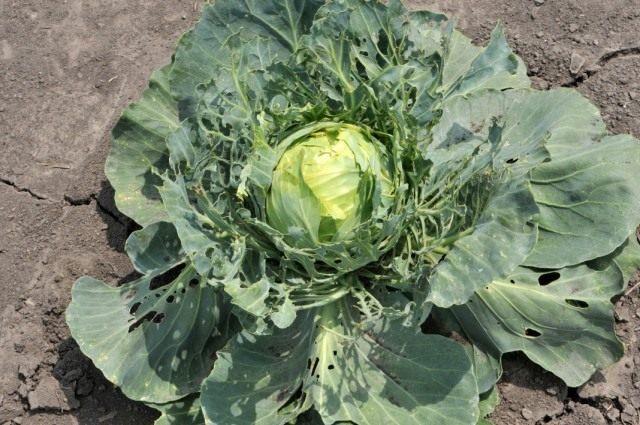
A massive attack of pests is visible on the damage on the leaves.
Gardener Tips
Simple tips will help you get a bountiful harvest:
- Cabbage pests don't like mustard powder. It is scattered around the plant.
- Sprinkle baking soda on the cabbage leaves to get rid of the caterpillars.
- Slugs and snails will help you collect special traps. The soil in the aisles is moistened. The newspaper is moistened in mash, kvass or beer. They are laid out around the heads of cabbage for the night. The pests will get drunk and easy to collect.
Conclusion
Cabbage pests significantly reduce yields and spread infections. Therefore, it is necessary to regularly carry out complex processing of the beds.

